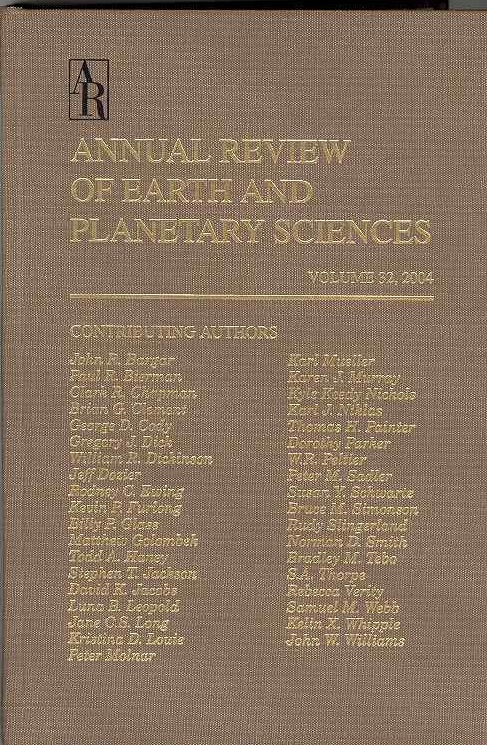山麓五十年:巴基斯坦新近纪Siwalik记录的生态系统演化
IF 13
1区 地球科学
Q1 ASTRONOMY & ASTROPHYSICS
Annual Review of Earth and Planetary Sciences
Pub Date : 2025-05-30
DOI:10.1146/annurev-earth-080723-082338
引用次数: 0
摘要
大陆化石记录具有特殊的、长序列的化石地层,是评价生态系统动态及其形成影响的基础。南亚的Siwalik序列就是一个例子。它发生在Potwar高原(巴基斯坦旁遮普省),跨度18 - 1ma。该层序由沉积在印度和欧亚构造板块碰撞形成的前陆盆地中的冲积沉积物组成。代表大小河道的沉积物及其伴生的洪泛平原沉积物对应于山源的大河和山麓源的小河。植被属性记录在古土壤的稳定碳同位素和生物标志物中。软体动物、鱼类、鳄鱼目动物、海龟、蜥蜴、蛇、鸟类和哺乳动物在整个序列中都被保存了下来。哺乳动物群的物种丰富度最高(116种),其中共生的大型食草动物多达18种(800公斤)。随着时间的推移,哺乳动物物种丰富度、分类组成和生态结构的显著变化与气候和植被的重大变化相一致。西瓦里克的地层和化石记录了喜马拉雅山脉以南的南亚大陆沉积物和生态系统的长连续序列。▪对构造、河流系统、气候历史和脊椎动物多样性的多学科分析记录了1800万至600万年前的生态系统动态。▪西瓦里克记录中与中新世气候最适宜期相吻合的稀疏部分提出了一种可能性,即湿热压力在这段时间的大部分时间里限制了大多数哺乳动物在洪泛区的活动。▪哺乳动物物种丰富度和生态结构变化的时间和幅度与环境强迫对这些特征的显著影响是一致的。本文章由计算机程序翻译,如有差异,请以英文原文为准。
Fifty Years in the Foothills: Ecosystem Evolution in the Neogene Siwalik Record of Pakistan
The continental fossil record has exceptional, long sequences of fossiliferous strata that are the basis for evaluating ecosystem dynamics and their formative influences. The Siwalik sequence of South Asia is one example. It occurs in the Potwar Plateau (Punjab Province, Pakistan) and spans 18–1 Ma. The sequence consists of alluvial sediments deposited in a foreland basin created by the collision of the Indian and Eurasian tectonic plates. Sediments representing large and small river channels and their associated floodplain deposits correspond to mountain-sourced large rivers and foothill-sourced smaller rivers. Vegetation attributes are recorded in stable carbon isotopes and biomarkers in paleosols. Molluscs, fishes, crocodilians, turtles, lizards, snakes, birds, and mammals are preserved throughout the sequence. Mammalian faunas had exceptionally high species richness (116 species) at their peak and included up to 18 species of co-occurring megaherbivores (>800 kg). Significant changes over time in species richness, taxonomic composition, and ecological structure of mammalian faunas coincided with major changes in climate and vegetation. ▪ Siwalik strata and fossils document a long continuous sequence of South Asian continental sediments and ecosystems south of the Himalaya Mountains. ▪ A multidisciplinary analysis of tectonics, fluvial systems, climate history, and vertebrate diversity documents ecosystem dynamics from 18 to 6 million years ago. ▪ A sparse portion of the Siwalik record coinciding with the Miocene Climatic Optimum raises the possibility that humid heat stress limited occupancy of the floodplain by most mammals for much of this time. ▪ The timing and magnitude of change in mammalian species richness and ecological structure are consistent with environmental forcing as a significant influence on these features.
求助全文
通过发布文献求助,成功后即可免费获取论文全文。
去求助
来源期刊

Annual Review of Earth and Planetary Sciences
地学天文-地球科学综合
CiteScore
25.10
自引率
0.00%
发文量
25
期刊介绍:
Since its establishment in 1973, the Annual Review of Earth and Planetary Sciences has been dedicated to providing comprehensive coverage of advancements in the field. This esteemed publication examines various aspects of earth and planetary sciences, encompassing climate, environment, geological hazards, planet formation, and the evolution of life. To ensure wider accessibility, the latest volume of the journal has transitioned from a gated model to open access through the Subscribe to Open program by Annual Reviews. Consequently, all articles published in this volume are now available under the Creative Commons Attribution (CC BY) license.
 求助内容:
求助内容: 应助结果提醒方式:
应助结果提醒方式:


